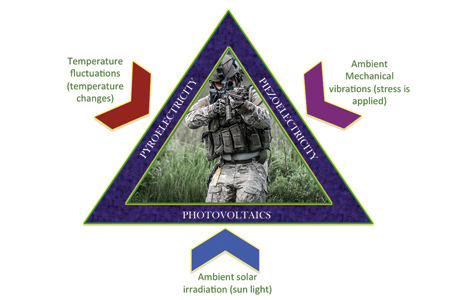Printed Energy Harvesters For Autonomous Military Applications
By Ashwith Chilvery, Xavier University and Silpika Karampuri, Alabama A&M University
Energy-harvesting technology, produced with innovative printing methods, has the potential to improve soldiers’ in-the-field capabilities while simultaneously trimming equipment weight and costs.
 Energy harvesting — also called energy scavenging or power harvesting — is the process by which ambient energy is captured and converted into electricity for small autonomous devices, such as satellites, laptops, and nodes in sensor networks, making them self-sufficient. In recent years, research on energy harvesters for medical, military, industrial, and commercial applications has greatly increased due to the harvesters’ instantaneous energy delivery, flexibility, and portability. Military applications are of particular interest, since energy harvesters are soldier-friendly, enhancing warriors’ capabilities in long-range and multifaceted battlefield endeavors. Power-harvesting technologies, operating with dependable efficiency, open the door to a host of new applications for a soldier’s wearable devices and other portable military electronics.
Energy harvesting — also called energy scavenging or power harvesting — is the process by which ambient energy is captured and converted into electricity for small autonomous devices, such as satellites, laptops, and nodes in sensor networks, making them self-sufficient. In recent years, research on energy harvesters for medical, military, industrial, and commercial applications has greatly increased due to the harvesters’ instantaneous energy delivery, flexibility, and portability. Military applications are of particular interest, since energy harvesters are soldier-friendly, enhancing warriors’ capabilities in long-range and multifaceted battlefield endeavors. Power-harvesting technologies, operating with dependable efficiency, open the door to a host of new applications for a soldier’s wearable devices and other portable military electronics.
This article examines future prospects and manufacturing possibilities surrounding a few of the most efficient energy-harvesting technologies: piezoelectricity, photovoltaic, and pyroelectricity (the “3 Ps”). Military devices based on the 3-P technology must exhibit exceptional durability to function in harsh environments with little human attention. Also, printing methodologies, such as gravure printing and nanoimprinting, could be key to manufacturing this technology. Thus, a detailed understanding of the 3 Ps and their manufacture is necessary to optimize performance.
Get unlimited access to:
Enter your credentials below to log in. Not yet a member of Photonics Online? Subscribe today.
